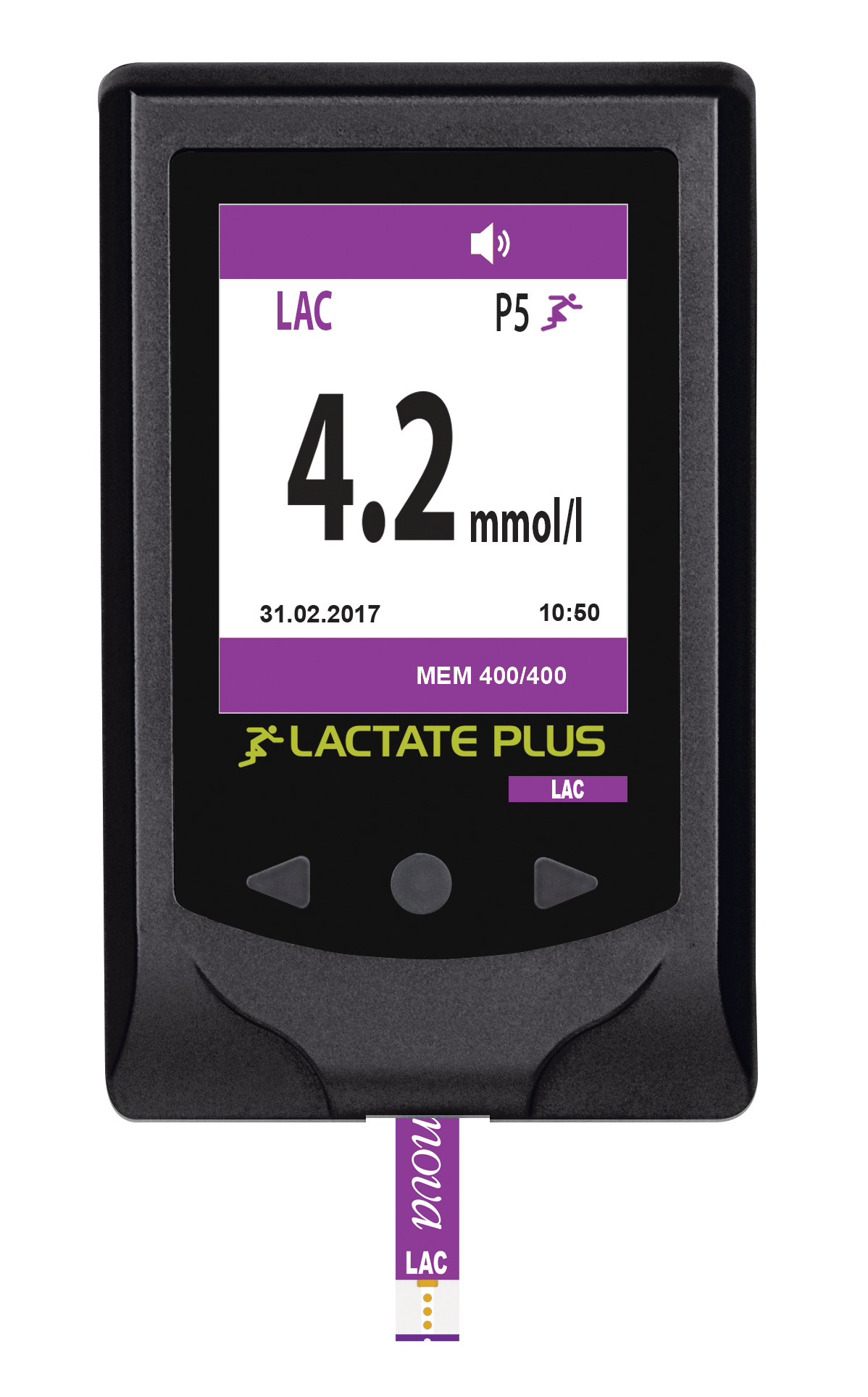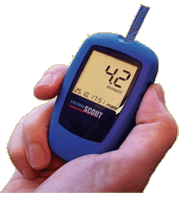Lactate Testing - Some Basics
This page is written in English even though it is meant for Portuguese speaking readers. We are looking for someone to translate English into Portuguese and who is familiar with exercise physiology and lactate testing.
If anyone is interested send us an email at info @ lactate.com and put in subject heading "English to Portuguese translations"
Science and Running Success
Measuring Lactate
Since lactate plays such a key part in energy production and athletic performance, sports physiologists and coaches have developed several ways to measure and monitor it. The most common way to measure lactate is to conduct a graded exercise test (sometimes called a graduated exercise test or GXT.) For example, the athlete will run, swim, cycle or row at progressively faster speeds, while a coach, sports physiologist, technician or trainer measures the lactate level at each speed. The athlete could also be on a stationary cycle ergometer and use power ratings instead of velocity. A rower could be rowing at a certain stroke rate or at a power rating on an rowing ergometer.
A different approach is necessary for athletes such as road cyclists, mountain bikers, distance runners and triathletes that compete on courses with hills and various types of uneven surfaces . There is no way to gauge how intense an effort is by speed alone even if they could measure speed. Instead an athlete uses heart rates as a estimate of effort. This is a very popular measure because heart rate monitors enable an athlete to know exactly what their heart rate is at all times. However, it is one thing to know your heart rate but it is quite another to know what that heart rate means in terms of stress on the body. Heart rates and stress vary substantially from person to person even of the same fitness levels. Heart rates must be calibrated with a lactate measure in order to have meaning. See Freqüência Cardíaca e Lactato section for a more thorough discussion
During the graded exercise test a coach gathers a variety of data. They then plot the data on a graph and produce a lactate performance curve (LPC). This curve is also called a lactate velocity curve (LVC). These curves are a plot of the lactate in the blood versus speed or effort. The following table is a typical form to record the results of a graded exercise test.

The coach will not necessarily use all these spaces especially if he/she is familiar with the athlete. As the athlete completes each stage, the coach fills in the relevant information.
An Example
The following is a chart for a woman preparing for the Ironman World Championship at Kona. She is performing a graded exercise test on a 400 m track and is using 2000 m stages which take about 6-9 minutes for each step. She completes five stages of 2000m and one final stage of 1000 m. This final stage is at maximum effort. As the coach gets to know the athlete better he/she may use only 3-4 steps. The times and lactate readings for this athlete are:

Notice that as the pace or effort goes up the lactate may at first show very little increase or even a decrease. Eventually, lactate levels start to rise very quickly. The pace and heart rate are increasing in a linear fashion while the lactate increases in an entirely different pattern. This is why it is difficult to predict lactate levels from heart rates. The lactate rises at first very slowly and then very fast. Eventually, the heart rate stops increasing because it has an upper limit, but the lactate continues to rise. At the final stage, with high lactate levels, the muscles hurt tremendously and they eventually cease to function most likely due to the acid buildup caused by the hydrogen ions.
Finding the Lactate Threshold
If the athlete never increased her speed after stage 1 and the coach took readings every 10 minutes the lactate reading would still be around 1.3. This means the athlete could run a long time at this rate. Since this athlete is an ironwoman triathlete, the pace could be kept up for several hours. At this speed, she would complete a marathon in about 3 hours and 20 minutes.
Somewhere between stage 1 at 3.5 m/s and stage 6 at 5.6 m/s there is a maximum pace that this athlete can maintain for a long period of time. At this maximum pace lactate has accumulated in many of the active muscles but it remains steady and is not enough to restrict contraction. Since it is the maximum pace at which lactate remains in a steady state for a substantial period of time it is sometimes called Maximal Lactate Steady State (MaxLass or MLSS). This makes sense even if it is hard to say. We like the term Lactate Threshold or LT because it is easy to remember and the point is primarily about lactate production and clearance. However, this point is most frequently called the Anaerobic Threshold, or AT. The last name has become the accepted term in popular training and amongst coaches and athletes but it is very controversial. (See section on Seção 2 Lactato e os Limiares para Treinamento.)
We have discussed why we don't like the term, "anaerobic threshold", in the Lactate Physiology section. We believe the term "anaerobic" is inappropriate because what determines this pace is primarily the ability of the body to clear and utilize lactate and not a switch to anaerobic metabolism. The LT usually takes place when there is plenty of oxygen in the system so this is not a limiting factor.
At any speed faster than LT or MLSS, the muscles will start to develop more and more lactate and eventually shut down. The higher the intensity of the exercise, the quicker lactate builds up. LT has had sort of a magical meaning to athletes. It is the maximum effort that can be kept up for a long time. This doesn't mean it is pleasant. It just means that if the athlete can ignore the discomfort that this pace eventually brings, his or her muscles will not shut down for a long while. Knowing this pace and the corresponding lactate in the blood can help the coach plan training sessions. The various Coaches' Guides to Lactate Analysis1 produced by Sports Resource Group contain several protocols to measure LT as well as protocols to confirm it.
Plotting the Data
Determination of the LT is an estimation process and usually starts with plotting a lactate performance curve. The curve below is a plot of the data from the ironwoman from above and is a typical lactate performance curve.
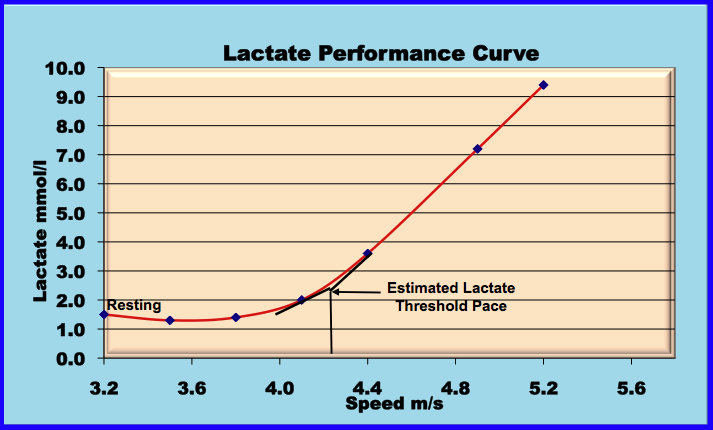
There is a sudden rise in the lactate between 4.1 m/s and 4.4 m/s. This indicates that the lactate threshold or LT will usually fall within this range. One way of estimating the LT is to complete the lines of the curve before and after the sudden rise in lactate. This is a rule of thumb but is based on sports physiologists analyzing thousands of lactate performance curves. Remember that this is an estimate and should be confirmed by the athlete with a constant effort test. (See example of a Confirmatory Test below.)
The estimated LT for this athlete is about 4.25 m/s or about 6:15 to 6:20 per mile. The heart rate at this speed is about 170 bpm. Runners often use this heart rate as an estimate of the effort necessary to train at LT. However, heart rate often drifts, usually upward, if this pace is maintained for a sustained period. (See section on Freqüência Cardíaca e Lactato.)
If the athlete could keep this LT pace up for an entire marathon the time would be around 2:45-2:55. Usually a marathon can not be run at LT pace because the muscles' supply of glycogen runs out. At the lactate threshold the body is using mostly carbohydrates and these will usually not last an entire marathon. So a marathon pace is typically just below the LT pace (about 8 m/min less). In an Ironman competition athletes must carefully protect carbohydrate stores and burn a mixture of fat and carbohydrates as fuel for most of the race. They do this by slowing down and racing at paces that utilize more fat. They will not be producing much lactate, which indicates less carbohydrate is being used as fuel.
Plotting Heart Rate and Lactate Together
Usually a distance runner or a cyclist will plot both heart rate and lactate on the same chart in order to estimate the heart rate at LT. The athlete will then be able to control pace on the road or on off road courses with heart rate. The following curve was plotted using data from an indoor cycling ergometer for a triathlete (See section on Freqüência Cardíaca e Lactato.).
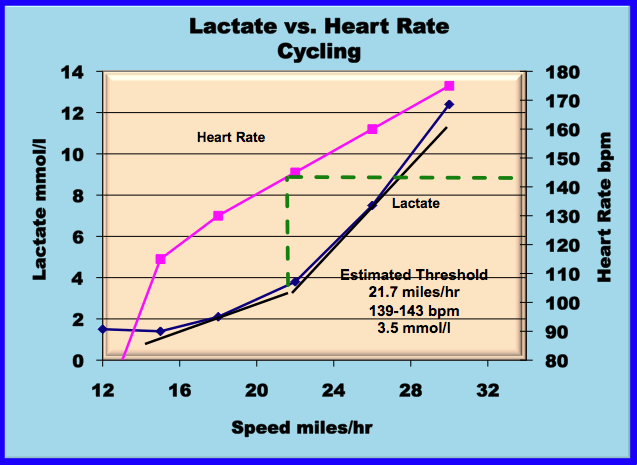
The athlete will use the heart rate, speed and lactate to plan training sessions both indoors on the ergometer or trainer and out on the road. This athlete should confirm these threshold values with a steady state confirmation test both indoors and on the road. Research has shown that heart rates and lactate levels on ergometers are frequently different from those measured during outdoor workouts.
Using Heart Rate as the Measure of Effort
Athletes such as triathletes, cyclists and distance runners often use a heart rate monitor to measure intensity when training and competing. Thus, when testing for threshold, they just compare heart rate and lactate and not worry about the pace at which they are running or the watts on the cycle they are riding. A test that uses heart rate as the measure of intensity will proceed just like any other graduated exercise test except when the athlete increases their effort, they strive for a specific heart rate and not a particular pace or power setting. Their coach will measure the lactate after they been exercising at the target heart rate for a specific amount of time (usually 3 minutes at each stage). The test proceeds till the athlete reaches exhaustion or a pre-determined lactate level.
Example - A woman triathlete periodically checks her heart rate against threshold for both cycling and running. She does this about 6 times a year especially after a reduction in training to make sure that preparation for the next major event will be on target. This particular test came just 4 weeks after a previous test that showed very low lactate at maximal effort. Her coach speculated that she might be overtrained or depleted of glycogen. He advised to watch her diet more carefully and reduce the intensity of some of her training. The coach took 9 readings. However, it is possible to conduct this test with fewer readings. The results of the test are in following table.
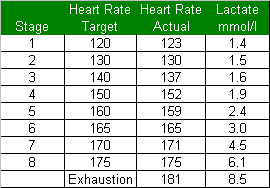
The chart below shows the Lactate/Heart Rate curve for this athlete. The coach was happy with the maximum lactate level and he estimated that this athlete had a threshold about 165 bpm and generates about 3.0 mmol of lactate at this heart rate. All cycling training for the next 4-6 weeks will be based on adjustments off this heart rate.
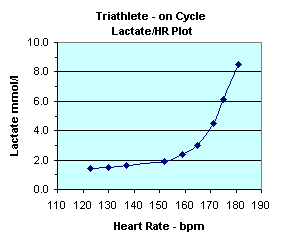
Typical Lactate Performance Curves
Who is faster, the sprinter or the marathoner? The sprinter is probably laughing at the question but the chart below shows that the marathoner has a much faster lactate threshold pace. This chart shows typical lactate performance curves for sprinters and marathoners. As you might guess, middle distance runners are in between. Notice that the longer the athlete's competitive distance the faster the pace at LT and the lower the lactate produced at LT. This does not mean the sprinter cannot run faster than the marathoner. For a hundred yards he/she certainly can. However, the pace a sprinter can keep up for any length of time is much slower than the marathoner's pace. Long distance runners tend to clear lactate very efficiently and usually have much lower lactate levels at threshold then other runners. Also notice the shape of the LPC. The marathoner has a less steep curve than the sprinter. We will discuss this again in the advanced testing concepts section. The slope of the curve reflects several factors that affect performance.
Steady State Tests
Another way of looking at lactate curves especially for an endurance athlete is to plot lactate levels at a constant speed over time. The chart below was completed for a female marathoner with very similar running performance to the ironwoman in the example above (the lactate levels at threshold are higher but the speed is about the same). This marathoner can run at 4.2 m/s for a long period of time but is forced to stop after 6,000 meters at 4.4 m/s. At 4.2 m/s she is running at her LT or very close to it. She is using primarily carbohydrates for this pace. At 4.0 m/s her lactate levels are lower and she is using some fat for energy. At 3.8 m/s she will be using an even higher percentage of fat for energy. A triathlete or marathoner would never complete the tests below except for research purposes but they should check their lactate levels occasionally at various points on a distance run or ride to see if their lactate levels are in the target range.

Confirmatory Test
A more typical constant speed test is a confirmation test that is used to verify the LT determined by other means. The example, below is a confirmatory test used in cycling2. A cyclist will cycle at three different power settings on a cycle ergometer, one slightly below the estimated threshold level determined through a graduated exercise test, one at the threshold level, and the last slightly above threshold level.
Blood lactate readings are taken every five minutes . The threshold is defined as the highest intensity level at which the last two lactate values of the 15 minute interval are the same. If the last 15 minutes shows level lactate values throughout the session, another 15 minute session is added. In the chart below, the results of 3 hypothetical cyclists are presented all with estimated thresholds of 330w.

Athlete A was estimated correctly. The middle segment, at 330w, shows flat lactate readings, while the final segment, at 360w, shows rising lactates. Athlete C, on the other hand, was estimated at too high a threshold. Only the first segment shows flat lactate readings. The middle segment, which is supposed to be a "steady-state" segment, has rising readings. Therefore the cyclist's threshold is between 300w and 330w. Athlete B has been estimated too low. Each segment shows essentially flat readings within the segment. Athlete B has not yet gotten to the point where lactate is starting to build up. He will need another 15 minute test to confirm his threshold, which is probably around 360w.
Comparing Lactate Performance Curves Over Time
While a single lactate performance curve (LPC) can be very instructive, a series of measurements taken over time can be invaluable. Typically, a coach will conduct a series of curves on an athlete over a season and over years. The LPC's will document the progress of the athlete preparing for a goal. The following example shows the progress of a cyclist during a season.

The early season lactate curve is a benchmark to compare later tests. The second test results were taken 10 days prior to an important competition. Things are going well. For every sub-maximal effort, lactate production is lower than before. The Lactate curve has shifted down and to the right. The Lactate threshold effort, which was under 300 w early in the season is now around 340 w. The maximum lactate produced is higher just prior to the competition, indicating that the cyclist has built more anaerobic power as well, and should perform well in attacks and sprints. This test indicates that the cyclist should have a very good race. We will meet this cyclist again it the Advanced Testing Section.
An Alternative Method for Tracking Aerobic Fitness over Time
US Rowing for several years used a very simple protocol to periodically test resident rowers and members trying out for US teams. It is a test any coach could do with access to an ergometer, a heart rate monitor and a portable lactate meter. On the first day the rower performs an all-out row on an ergometer for 2000 m. The coach or sports physiologist calculates the average power sustained for the test. This is designated as the rower's Max Power. On most ergometers this can be monitored very easily.
Suppose a rower is able to average 450 watts for the 2000 m row. On the next day this rower will complete 3 five-minute rows with a 3 minute rest between each exercise. The first will be at 60% of Max power (270 watts for this rower), the second effort will be at 70% (315 watts) and the final effort will be at 80% (360 watts.)
While US Rowing uses sophisticated equipment to measure oxygen and carbon dioxide, the average coach does not have access to such equipment. However, any coach can use the heart rate monitor and the portable lactate meter to measure other meaningful variables and have access to important information that will help plan training for athletes.
The two tables below lists the lactate and heart rate results for six heavyweight male rowers. The tests in the charts were about 8 weeks apart.. Notice that on the lactate measure all of the rowers improved except one. Rower C had higher lactate readings at the second test for all three effort levels. This should be a red flag for the coach. Maybe the coach suspected there was something wrong with Rower C or it could have been a bad day for many reasons. The coach might want to test Rower C again in a week to see if the test was not indicative of his fitness. Whatever the cause of the poor results the coach is now aware that something might be wrong.

If the coach looked at the heart rates from the two tests, he would not suspect anything wrong. Rower C's heart rates have improved (declined) at each effort level. Also from looking just at the heart rates it would be hard to pick out which of the rowers was progressing the most. However, when lactate values are combined with the heart rates a more complete picture is available.
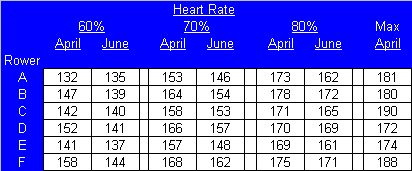
Dr. F. Hagerman, who used this test and had worked extensively with US Rowing, says that when an athlete is at or near peak condition the tests should elicit the following responses3:

While this test was designed for rowing, a similar test would also be effective for other endurance sports such as running and cycling. The athlete would not have to use an ergometer or treadmill but should perform the test on some sort of measured distance. The course should be the same for each test in order to be comparable.
Non Fitness Factors That Affect the Lactate Threshold
Everyone acknowledges the value of knowing the lactate threshold. However, some coaches have disparaged the use of lactate testing to measure the individual's lactate threshold because external factors may affect the tests, e.g. diet, fatigue, temperature, emotional states. But the external factors that can cause a lactate test to vary, will also cause any other test to vary. Whether the athlete uses a distance test, repeated sets, step tests, time to exhaustion, percent of maximum effort, heart rate profiles or some other methodology, external factors can affect the results. The important point is for the coach to know what the most common factors are and try to control them. The key is to be consistent. Some of the factors are:
- Time of Day - Most athletes have a slower velocity at threshold in
the morning than the afternoon. Any paces set using an afternoon test will
probably be too fast for morning workouts. This does not invalidate the
testing method; it just means that coaches need to adjust speeds down a second
or two for early morning sets. You may find some athletes who thrive early in
the morning. In this case you may want to adjust their times for a slightly
faster rate in the morning.
The threshold speed between morning and afternoon workouts can vary dramatically. For example, in swimming one coach4 has found up to 4 seconds per 100 m difference between morning and afternoon thresholds for some of his swimmers. He attributes this to a change in enzyme and chemical activity within the body. He also has found that the anaerobic system will vary between morning and afternoon. This has obvious implications for competition as some athletes are able to compete much better in one part of the day versus the other. Tests should be done for both morning and afternoon sessions to assess the differences between the two periods.
- Recent Heavy Training or Competition - Athletes usually have a
slower threshold after hard workouts the day before. If training the day
prior to testing is conducted at a low intensity, then the threshold should
not be affected by glycogen depletion. Another problem is the interference of
weight training with testing. One coach was getting some unexpected readings
until he realized that some of his athletes had just completed a weight
training session a couple of hours prior to the testing.
- Diet - An athlete should eat plenty of carbohydrates the day
before and the day of the test. This should ensure there is plenty of
glycogen available in the muscles and that low glycogen will not affect the
testing. Athletes should not drink Coke or any other drink containing
caffeine before the test. Make sure the athlete is not dehydrated during the
test.
- Weather and Temperature - Heat and humidity affect athletes
differently. There is a tendency for lactate readings to be higher in hot
weather. If the testing is done outdoors, it becomes important to record the
heat and humidity during testing so the coach can use this as a reference to
compare one test period with another. Heart rate is also affected by heat and
may not vary the same way that lactate will vary. So using heart rate to
estimate threshold in extreme hot or cold weather could be misleading. Do not
do testing on a windy day. Also if an athlete changes location and moves to a
higher or lower altitude, then the lactate threshold has to be calculated for
the new altitude.
- Other Factors- The coach should use the same protocol or test procedure each time. Modifying the test reduces the comparability of the results. If the coach uses 400 m swims, 2000 m runs or 6 minute rides on a bike for a test, then he should use the same distances or times for the next testing. The test should not be done indoors on an ergometer one time then outdoors on the road the next. Use a protocol that is specific to the athlete's event. Don't test a runner on a cycle ergometer or a cyclist on a treadmill. Don't test a butterfly specialist with a freestyle protocol.
By saying that test conditions need to be controlled, we do not mean to undermine the value of testing. You must set training paces that are relevant to each athlete and any method used to gauge the right paces will be subject to the same problems listed above. It is not possible to set the perfect pace for each athlete for every workout during a week. Lactate testing provides the best estimate of the lactate threshold but it is an estimate. Coaches and athletes, as they become experienced in the use of lactate testing, can adjust up or down depending upon an athlete's experience with paces based on the estimated lactate threshold and circumstances such as time of day, day of week, weather and recent workouts.
For English reading visitors, there is much more on lactate testing other parts of the site.
Home Page |Lactate Plus | Lactate Scout | Triathlon | Thresholds | CD-ROM
For Portuguese Reading visitors the following links are some additional links
Alto da Página | Página principal | Página principal en Español | English Home Page
A Fisiologia do Lactato e o Treinamento Esportivo
- Seção 1 - Terminologia e Conceitos Básicos.
- Seção 2 - Lactato e o Limiar para o Treinamento.
- Seção 3 - Razões para Utilizar a Análise de Lactato. (em Inglês)
- Seção 4 - O Lactato e os Sistemas Energéticos. (em Inglês)
- Seção 5 - A Produção e a Remoção do Lactato, e o Treinamento de Resistência. (em Inglês)
- Freqüência Cardíaca e o Lactato.


